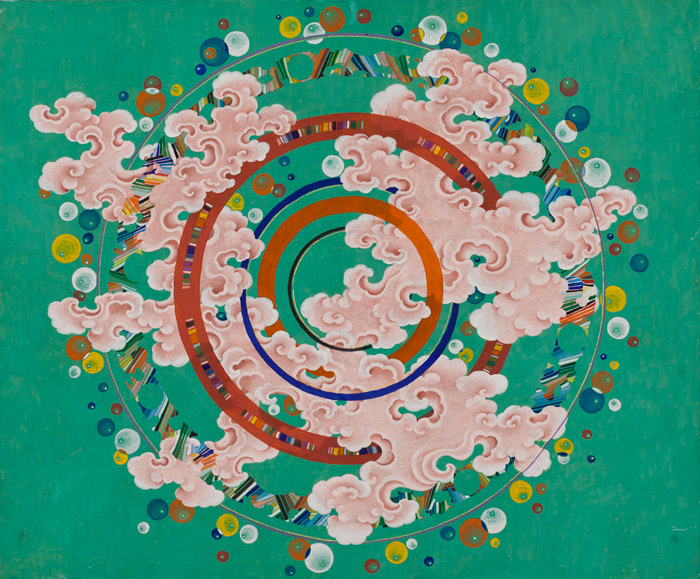Joshua Liner Gallery houses a diverse group of established and emerging artists, but as a faction they present a united front against creative tedium. Ai Yamaguchi’s celluloid expressions and frail lines depict lives of young prostitutes. Evan Hecox portrays urban environments through amplification and select graphic elements. Julie Opperman’s dissonant paintings use the viewer’s perception as a medium. The common thread among artists at Joshua Liner is this: they all work to erode boundaries. They are eager to jump the old divides between traditional and contemporary, puppeteering and sculpture, graphic design and fine art. They shun categorization. Pema Rinzin is no exception.
Rinzin employs traditional thangka painting techniques and materials to create contemporary work. He has taught and traveled in Germany and Japan, translated for monks on tour with the Grateful Dead, and spent time at the Rubin Museum of Art in New York. His paintings are held in various public and private collections, including the Dalai Lama’s.
These pieces are simple, powerful, and abstract. The content is forms distilled to their essences, with the exception of the Auspicious Dreams series, which contains vastly detailed forms from all walks of the animal kingdom that surge in pleasant turmoil around a golden orb. Rinzin’s paintings appear both biological and intergalactic in a way that speaks to the enigmatic scale of daily life. Shapes within could be cells, spores, or immense bodies of matter floating in space. He uses ground mineral pigments as a medium—gold, as seen in the three Auspicious Dreams paintings, as well as green malachite, and lapis lazuli. All of these are of gem quality. The intensity of the colorants enhances the qualities of playfulness and surprise in his work.
I was able to ask Rinzin a few questions about his paintings, process, and hopes for this “Abstract Enlightenment.”
Maria Anderson: This is your second solo show at Joshua Liner Gallery. What is most important to you about this exhibition?
Pema Rinzin: Naturally, there is the hope that people like it. Not only this, but that these paintings will cause people to believe that today is not the only life we have. We have tomorrow. We have the next day, and the next. We don’t have to sell our paintings today. We don’t have to be successful today. What I want is to pause time.
MA: You’ve mentioned that you abstract impressionist is a description you would place, however loosely, on your work. Why the name Abstract Enlightenment?
PR: It has to do with the feeling of your mind opening up—everything spans out, like a sun. Bubble of Wishful Gems is like this, with the two concentric circles. It has a lot of movement, a lot of joy and expression. The inside looks like seeds, so it’s almost like a flower petal. In Tibet, this shade of blue is considered the highest color of emptiness and ascension. Nature yields a lot of energy, and I’m making use of this. Enlightenment is when you’re abstract in the composition and the subject. It’s about trying to represent the essence of all things in a simple way.
MA: Does meditation, or, to use a word with fewer associations, contemplation, play any role in your creative process? In other words, how do you reach a state of mind that allows for long hours of intuitive, focused painting?
PR: There is a principle on how to use meditation: the best meditation for me is not how people typically think of it. If you are a focused person, you might wake up in the morning and exercise—something like this is the best meditation. You meditate to purify yourself to do things right. If you’re a teacher, and if you teach and use your heart, then this is a great meditation. If you teach by example and not from the mouth or the book, this becomes like a meditation. It is more of a belief system.
After a while, when you paint more and more, it becomes automatic. You connect. It’s a natural meditation. You can close your eyes and sit quietly and meditate, but doing just this won’t help you paint. You have to use your hand, your mind, your body. Oh, if you focus in this way, you will be happy! You can’t separate it from your work.
MA: What else is crucial to your process?
PR: Intention and discipline. You have to know how to clean your house. If you are a good artist, you have to know how to cook. This makes other people happy, and then you are happy. Making yourself happy first is even more important than making others happy. If you do a very good painting today, then the next painting will be more challenging, and when you are challenged, you are better able to be good to others.
























